|
|
||||
|
Published by : PROFESSIONAL MEDICAL PUBLICATIONS |
||||
|
ISSN 1681-715X |
||||
|
||||
|
- |
||||
|
ORIGINAL ARTICLE |
||||
|
- |
||||
|
Volume 24 |
April - June 2008 (Part-I) |
Number 2 |
||
|
|
||||
|
||||
|
|
||||
|
Published by : PROFESSIONAL MEDICAL PUBLICATIONS |
||||
|
ISSN 1681-715X |
||||
|
||||
|
- |
||||
|
ORIGINAL ARTICLE |
||||
|
- |
||||
|
Volume 24 |
April - June 2008 (Part-I) |
Number 2 |
||
|
|
||||
|
||||
Incidence of human malaria infection in Barkhan
and Kohlu, bordering areas of East Balochistan
Mohammad Iqbal Yasinzai1, Juma Khan Kakarsulemankhel2
ABSTRACT
Objective: To determine the incidence of malarial parasites in human population of Barkhan and Kohlu areas of Pakistan.
Methodology: Malarial parasites were identified in the blood slides of suspected patients of the disease from July 2004 to June 2006 and encompassed 3340 subjects.
Results: Out of 3340 suspected cases of malaria, 1095 (32.78%) were found to be positive for malarial parasite in blood smear slides. Out of positive cases, 579 (52.87%) were identified as Plasmodium falciparum infection and 516 (47.12%) cases with P. vivax. There was no case of Plasmodium malariae and P. ovale infection observed in the present study.
Conclusion: The prevalence rate of 52.87% (579/1095) of P. falciparum poses a significant health hazard because not only P. falciparum infection but infection with P. vivax 47.12% (516/1095) may also lead to serious complications like cerebral malaria. Infection with P. falciparum was found to be more prevalent in Barkhan and Kohlu area. It seems that there is no association between types of infection and age groups.
KEY WORDS: Malarial parasite, Plasmodium falciparum, P. vivax.
Pak J Med Sci April - June 2008 (Part-I) Vol. 24 No. 2 306-310
1. Mohammad Iqbal Yasinzai,
Department of Zoology,
2. Juma Khan Kakarsulemankhel,
Incharge, Sandflies,
Leishmania & Arthropods Vectors Lab. / Zoology,
1-2: University of Balochistan,
Sariab Road, Quetta-87300,
Pakistan.
Correspondence:
Juma Khan Kakarsulemankhel,
E-mail:
dr.jumakhankakarsulemankhel@yahoo.com
kakarjumakhan@yahoo.com
* Received for Publication: July 5, 2007
* Revision Received: November 5, 2007
* Revision Accepted: January 10, 2008
INTRODUCTION
Among blood infections, malaria is the most widespread, a global threat and potentially a public health problem of the tropics with its morbidity and mortality at unacceptable high levels in the region.
1 According to World Health Organization study group2 malaria is a major killer of mankind and is responsible for 300 to 500 million clinical cases and 1.5 to 2.7 million deaths per year. Some 270 million new cases of malaria occur every year of which 95% are reported from these areas.3 Falciparum and vivax malaria are major health problems in Pakistan. In the last decade there has been a six fold increase in falciparum malaria, which now comprises 42% of all malaria cases recorded by National Malaria Control Program.4 At least 39 districts, mainly from the two southern provinces of Balochistan and Sindh, have been classified at high risk, partly due to the weak public health infrastructure.In Pakistan, Bano and Mufti
5 studied human malaria in a selected population of Peshawar. Hadi et al.6 investigated endemic malaria in Punjab children. Malaria in Afghan refugees in Pakistan was studied by Suleman7 and observed that malaria in Afghan refugees is higher than in the local population. Nizamani et al8 investigated fifty cases of cerebral malaria in children in Liaqat Medical College Hospital, Jamshoro. In Balochistan too, cerebral malaria is a major community problem. Nawaz and Yasmin 9 studied the prevalence of malaria in Afghan refugees settled in urban areas of district Quetta. Yasinzai and Kakarsulemankhel10,11 investigated the prevalence of malaria infection in urban and rural areas of Quetta district. However, the present study was carried out to find out the prevalence of malarial parasites in human populations residing in the districts of Barkhan and Kohlu. This is perhaps the first study of its find conducted on patients suffering from Malaria in these areas.METHODOLOGY
A survey was conducted during July, 2004 to June, 2006 in the areas of districts of Barkhan and Kohlu to record and screen the species of malarial parasites from the blood of human patients suffering from malaria.
Malaria cases were detected by adapting two ways. Passive case detection (PCD) technique where in blood films were taken from the patients presenting themselves to a health station with symptoms of shivering and fever or a history suggestive of malaria. The other technique is active case detection (ACD)
12 in which home visits were made to the persons with sign or symptoms of malaria and blood films of both thin and thick were prepared. Blood slides were taken back to the laboratory where they were stained in Giemsaís stain following the techniques described by Manson-Bahr and Bell.12 Identification of species of malarial parasites were made from the keys furnished by Service13 and Sood.14RESULTS
A total of 3340 blood smears were prepared from the age groups ranging from one year to 21 years and above residing in ten and seven different localities of Barkhan (Table-I-II) and Kohlu (Table-III & IV) respectively. However, variations were observed among different localities having different hygienic conditions.
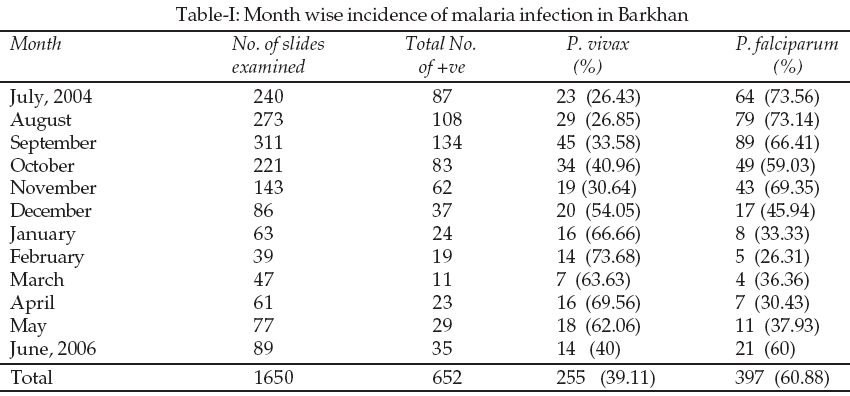
In Barkhan area (Table-I-II), the over all incidence of Plasmodium slide positivity was 32.78% (1095/3340), whereas Plasmodium falciparum positivity was observed to be highest (52.87%: 579/1095) as compared with that of P. vivax (47.12%: 516/1095).

Among Plasmodium slide positivity, children (1-10 years), 60.11% (107/178) were positive for P. falciparum and 39.88 % (71/178) for P. vivax. The commonest species of malarial parasites observed was P. falciparum (Fig-I) with a highest incidence of 65.80 % (152/231) in the age group of 21 years and above, and 56.79 % (138/243) in the age group of 11-20 years.
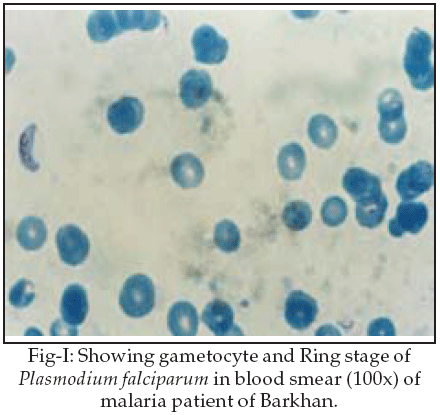
P. vivax (Fig-II) was also observed to be present in our study but comparatively with a less prevalence ratio of 43.20 % (105/243) in the age group of 11-20 years and 34.19 % (79/231) in the age group of 21 years and above.
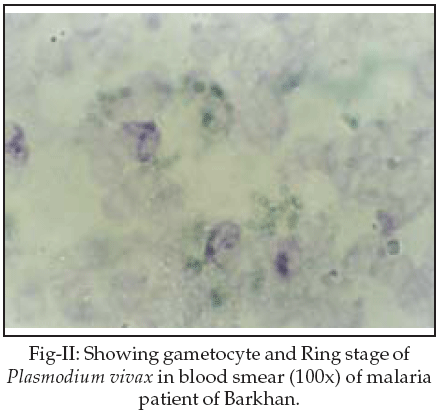
Table-I&II (Barkhan area) was statistically analyzed to test whether there is any association between types of infection and age groups through X
2 at 5% level of significance, X2 calculated as 4.1009 and compared with the table value of X2= 5.991. Since calculated value of X2 is less than the table value so it is calculated that there is no association between types of infection and age groups. Therefore, it can be said that any type of infection can occur in to any age group of people independently.

DISCUSSION
Yasinzai and Kakarsulemankhel
10,11 while conducting results on human malaria infection in urban and rural areas of Quetta district observed high prevalence of P. falciparum (55.55%: 75/135and 65.82%: 235/357) and a low incidence of P. vivax (44.44%: 60/135 and 34.17%: 122/357 However, mixed infection of P. vivax and P. falciparum was not seen in patients of Quetta urban and rural areas. Akbar15 and Hozhabri et al16 while investigating malaria in children at Combined Military Hospital Multan, D.G. Khan, Muzaffargarh, adjoining areas of Balochistan; Sehwan area of Dadu, observed high prevalence of P. falciparum than P. vivax (65% vs 35%) respectively.
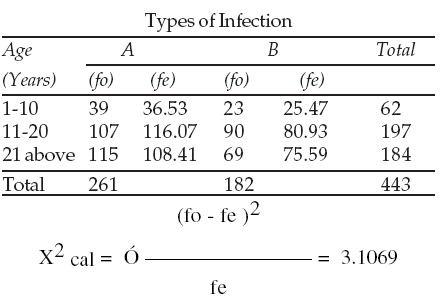
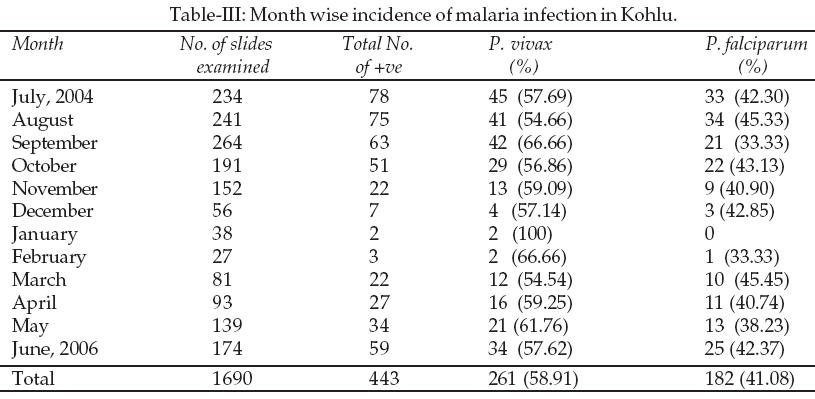
In Kohlu area (Table-III-IV), the over all incidence of Plasmodium slide positivity was 26.21% (443/1690) wherein P. vivax (Fig.-III) infection was found to highest (58.91%: 261/443) as compared with the P. falciparum (41.08%: 182/443) (Fig-IV). Among plasmodium slide positivity, children (1-10 years), 62.90% (39/62) were found to be positive for P. vivax and 37.09% (23/62) for P. falciparum. The commonest species of malarial parasites observed was P. vivax (Fig-III) with a highest incidence of 62.50% (115/184) in the age group of 21 years and above, 54.31% (107/197) in the age group of 11-20 years. However, P. falciparum was also found to be present with a low prevalence ratio of 45.68% (90/197), 37.50% (69/184) in the age groups of 11-20 years and 21 years and above respectively.
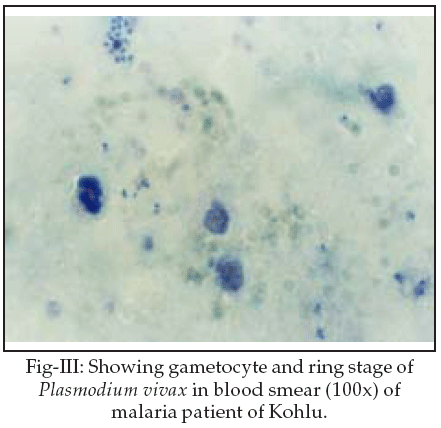
Table-III-IV (Kohlu area) was statistically analyzed to test whether there is any association between types of infection and age groups through X2 at 5% level of significance, X2 calculated as 3.1069 and compared with the table value of X2= 5.991. Since calculated value of X2 is less than the table value so it is observed that there is no association between types of infection and age groups. Therefore, it can be said that any type of infection can occur at any age group of people independently.

Similarly, P. vivax was found to be highest (60.5%: 52 out of 86 positive cases) in Multan district by Yar et al.17 than P. falciparum (37.2%: 32 out of 86 positive cases). Similarly, Jan and Kiani18 investigating haematozoan parasites in Kashmiri refugees settled in Muzzafarabad observed high prevalence of P. vivax (6.33%) than P. falciparum (0.67%).
However, mixed infection of P. vivax and P. falciparum was not observed in the present study, as mixed infection of 2.3% was observed in Multan district by Yar et al.17 In the present study, no case of P. malariae or P. ovale infection was observed, as the same was also not observed by Yar et al.17 in Multan.
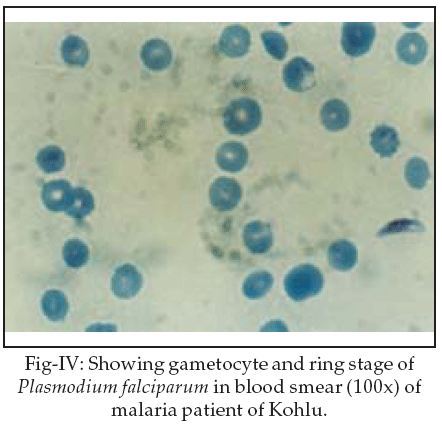
In our study, the prevalence rate of 52.87% (579/1095) of P. falciparum poses a significant health hazard because not only P. falciparum infection but infection with P. vivax 47.12% (516/1095) may also lead to serious complications like cerebral malaria. We therefore conclude that infection with P. falciparum was found to be more prevalent in Barkhan are whereas P. vivax in Kohlu areas.
ACKNOWLEDGEMENT
This study was conducted with financial support from the Higher Education Commission Government of Pakistan through Balochistan University, which is gratefully acknowledged.
REFERENCES
1. Cabe J. Natl Inst Hlth News Release 2001;1-2.
2. World Health Organization Study Group. Implementation of the global malaria control strategy. WHO Geneva Switzerland 1993.
3. Anwar M, Saleem M, Zaheeruddin. Malaria: A challenge to meet. Pak Armed Forces Med J 1994;44:1-3.
4. Shah I, Rowland M, Mehmood P. Chloroquine resistance in Pakistan and the upsurge of falciparum malaria in Pakistan and Afghan refugee population. Ann Trop Med Parasitol 1997;91:591-602.
5. Bano L, Mufti SA. A study of human malaria in selected population of Peshawar. Progress in medicine. Pak J Med Res 1980;1x(3-4):34-6.
6. Hadi H, Fox E, Strickland GT, Pervez M, Chowdhry MA. Endemic malaria in Punjab children: a diagnostic challenge. Pak J Med Res 1985;24,2:63-8.
7. Suleman M. Malaria in Afghan refugees in Pakistan. Trans Roy Soc Trop Med Hyg 1988;82,1:44-7.
8. Nizamani MA, Hassan M, Memon A. Cerebral malaria in children: a study of children a study of 50 cases. Pak Paed J 1995;19,1:1-7.
9. Nawaz M, Yasmin N. Prevalence of malaria in afghan refugee settled in urban areas of district Quetta. 7th Pak Congr Zool 1987;Abstract:10.
10. Yasinzai MI, Kakarsulemankhel JK: Incidence of malaria infection in rural areas of District Quetta, Pakistan. On Line J Med Sci 2003;3,9:766-72.
11. Yasinzai MI, Kakarsulemankhel JK: A study of prevalence of malaria infection in urban areas of district Quetta, Pakistan. Pak J Zool 2004;36,1:75-9.
12. Manson-Bahr PEC, Bell, DR. Mansonís Tropical Disease. 19th Edition. London: English Language Book Society/ Bailliere Tindall,1987.
13. Service MW. Lecture Notes on Medical Entomology. Oxford: Blackwell Scientific Publications 1986.
14. Sood R. Haematology, 3rd Edition. New Delhi: Jaypee Brothers, Med. Publishers (P), Ltd., 1989.
15. Akbar JU. Malaria in children at a children Hospital. J Coll Phys Surg Pak 2002;7,3:20-2.
16. Hozhabri S, Akhtar S, Rahbar M, Luby S. Prevalence of plasmodium slides positively among the children treated for malaria, Jhangara, Sindh. J Pak Med Assoc 2000;50,2:401-5.
17. Yar HM, Masood K, Maqbool A, Malik GQ. Prevalence of malarial parasite species in Multan district. The Professional 1998;5:183-7.
18. Jan AH, Kiani TA. Haematozoan parasites in Kashmiri refugees. Pak J Med Res 2001;40,1:10-12.
HOME | SEARCH | CURRENT ISSUE | PAST ISSUES
Professional
Medical Publications
Room No. 522, 5th Floor, Panorama Centre
Building No. 2, P.O. Box 8766, Saddar, Karachi - Pakistan.
Phones : 5688791, 5689285 Fax : 5689860
pjms@pjms.com.pk